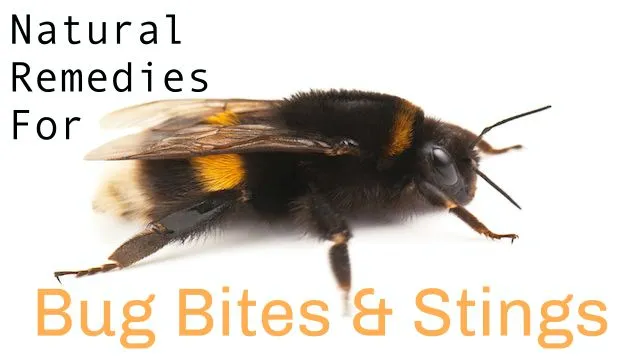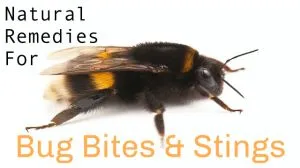
- Share on Facebook68
- Share on Pinterest
- Share on Twitter
It’s great to get outside in the summer and enjoy the sunshine, fresh air and green surroundings filled with life. It’s high time to get the dog and kids out of the house to experience the natural environment.
However, summer comes with its own set of dangers and concerns. Sunburn is probably the most obvious, but insects are a close second. We recommend using natural insect repellents to ward off any pesky creatures, but bites and stings can’t be entirely avoided and they will still happen once in a while.
When you or someone in your family has a run-in with any type of creepy crawly, it’s best to use natural solutions to provide comfort and relief. We’ve put together an extensive collection of the best home remedies for any type of insect bite or sting that might come your way this season. You can make and stock up on these simple treatments in advance so that you will be ready in case of any unfortunate events in the coming months.
Bees and wasps
It should go without saying that natural bee sting treatments are most likely inappropriate for those with an allergy. Approximately three percent of people will experience a life-threatening anaphylactic reaction to bee stings. Signs of a severe allergic reaction include hives or welts on the skin, rapid swelling, shortness of breath and feeling dizzy. In this case, it is necessary to seek immediate medical attention.
In the event of a bee sting to a non-allergic person, there will probably still be a great deal of discomfort, including swelling, itching and pain.
The first step of treatment will be to remove the stinger. It contains venom and can keep pumping the toxic liquid into the skin if it is left in place. You may use any method to remove the stinger as quickly as possible, while being careful not to break it or leave any of it behind. A small, purpose-made, venom-extraction suction kit is a smart purchase that will enable you to safely remove the stinger and venom, particularly if bees and wasps are common around your home.
The next step is to wash the site of the sting using a gentle soap and some cool water. Otherwise bacteria may stay behind and cause an infection.
After the sting area has been cleaned, the goal is to prevent excessive swelling and soothe the skin. You may try any of the following simple and non-toxic treatments to help relieve discomfort:
Plantain leaves: Plantago major is a common “weed” that grows throughout cities and inhabited areas. It is a very useful and potent medicinal plant and probably one of the fastest, most immediately available remedies for a bite or sting. Simply pick a couple of leaves (preferably from a location that has not been treated with pesticides) and brush off any dirt. Extract the juices by either squeezing and “bruising” the leaves, or chewing them. Apply the mashed leaves over the affected area and hold them there for half an hour. This treatment can be repeated as needed. Optionally you can cover the area with a damp cloth while the medicinal compounds are soaking in.
Lavender essential oil: This is a simple and child-friendly remedy that will help neutralize venom and calm skin inflammation. Simply apply 2–3 drops directly to the site of the sting. If you are concerned about using pure essential oil (i.e. on babies or small children), dilute it with some carrier oil such as coconut oil. A helpful side effect of this aromatic treatment will be to assist in calming any panic the sting victim might be feeling.
Honey: Ironically, honey can be a great help in soothing bee stings. Ideally you will use raw local honey or a medicinal honey such as manuka. Honey has antibacterial properties that will help prevent the injury site from getting infected. Simply apply honey generously to the site as needed to provide comfort.
Any of these treatments can be used in conjunction with cold packs or ice wrapped in a towel, which will work to reduce swelling and pain in the area.
Spiders
Spider bites can vary widely in the symptoms they cause. They might be itchy or painful, or cause a strange-looking bump. If the victim has a sore that doesn’t seem to go away or is growing, this may be a symptom of a seriously poisonous bite, in which case, don’t hesitate to seek medical attention.
Again with spider bites, a small DIY suction venom removal kit is a great way to extract the irritating liquid from the skin.
Here are some further ways to neutralize the toxins that will be present at the injury site:
Baking soda: Mix a teaspoon of baking soda into a paste with a little bit of water and apply it over the bite. It has a natural drawing ability, which will effectively pull toxins out of the skin.
Salt: Similarly to the baking soda, salt should be applied with a small amount of water. Salt will help prevent infection and reduce inflammation.
Activated charcoal and bentonite clay: These natural powders have the amazing ability to bind to toxins. Those suffering a spider bite should use a paste made of activated charcoal or bentonite clay applied to the skin. This can be cleaned off and replaced a few times a day for the first day or two after receiving the bite. After the initial period, the bite can be closely monitored to ensure it is improving. Health experts also recommend consuming activated charcoal capsules or a bentonite clay drink internally to help absorb and export toxins from the body.
Ticks
Ticks and their bites can be very dangerous, since they might carry infections and diseases. Be sure to inspect your body and clothing often when you are in an area where ticks are common. Pets can also pick up ticks.
Neem oil: Neem oil is strongly antibacterial and antiseptic. It can help “drown” the tick to cut off its air supply and encourage it to withdraw from the flesh. Apply several drops as soon as possible after the tick is discovered.
Apple cider vinegar: Apple cider vinegar can be beneficial for removing ticks. You can make a medicinal tonic with neem oil, and apply it to the affected area. You can also use this on dogs who may be affected by ticks. Take 500 ml of water and add four tablespoons of apple cider vinegar to it. Stir the mixture well adding two tablespoons of neem oil.
Essential oils: Natural aromatic oils are strongly repellent to ticks. You can apply a drop or two straight to the skin for the strongest medicinal effect, or dilute with an oil such as sweet almond oil for use on sensitive people or pets. The most effective essential oils are basil, lemon, orange, cinnamon, cedarwood and lavender. These oils will also help fight any infection carried by the tick, although you should be sure to seek the attention of a qualified professional.
Itchy bites — mosquitoes and chiggers
Bites from insects such as mosquitoes and chiggers are usually relatively harmless, but they sure are itchy. This can be a problem especially with children who can scratch the bites open and leave scabs and scars.
Try these natural remedies to take away the itch of mosquito and chigger bites:
Witch hazel: Buy a simple witch hazel distillate from a health food store, and apply it to the bites. It brings down irritation and swelling.
Black tea: Simply wet a black tea bag and apply it to the bite area. The tannins in the tea will “draw” the skin to take away the itch.
 Diatomaceous earth: You can buy this fine natural powder from health food stores or online. Be sure to buy the food-grade diatomaceous earth, rather than the lower quality type which is used in pool filters. Simply make a paste with a little water and apply to itchy bites.
Diatomaceous earth: You can buy this fine natural powder from health food stores or online. Be sure to buy the food-grade diatomaceous earth, rather than the lower quality type which is used in pool filters. Simply make a paste with a little water and apply to itchy bites.
Essential oils: Some natural oils such as peppermint, tea tree (also known as melaleuca) and lavender have been said to work wonders on itchy bites. Simply apply a drop to each bite. Be aware that peppermint oil can cause an intense cooling sensation, so use with caution on children, or dilute it with carrier oils. Some people have skin reactions to lower quality tea tree oil. We recommend that you seek out a high quality product.
Red ants
Ant bites can be painful, but also very itchy. The skin may present with small blisters, which can be very irritating. Try applying these remedies to soothe the skin and bring down the inflammatory reaction.
Vinegar or alcohol: Both of these natural remedies produce a cooling sensation and reduce the action of histamines, which would otherwise cause swelling at the site.
Aloe vera: You can keep your own aloe vera plant, or buy pure aloe vera gel from a health food store. The plant’s natural gel has amazing medicinal and health properties. It heals insect bites while soothing irritation and swelling, and boosting immune response.
Hopefully you feel prepared to take on any and all insect bites that might come your way this summer. There is a powerful natural remedy for everything!
—The Alternative Daily
Sources:
http://www.cabdirect.org/abstracts/19910504125.html;jsessionid=0B6F8805E242430B4486080E827B1728
http://journals.lww.com/co-allergy/Abstract/2011/10000/Pathophysiology_of_itch_and_new_treatments.7.aspx
http://www.nejm.org/doi/full/10.1056/NEJMoa011699
http://www.motherearthnews.com/natural-health/bee-sting-treatment-zbcz1310.aspx
http://www.everydayhealth.com/skin-and-beauty-pictures/18-home-cures-for-mosquito-bite-itch.aspx
http://www.homeremedyshop.com/home-remedies-for-ticks
http://www.kitchenstewardship.com/2014/06/26/get-the-itch-out-natural-bug-bite-relief-options
http://www.earthclinic.com/cures/spider_bite.html
- Share on Facebook68
- Share on Pinterest
- Share on Twitter

